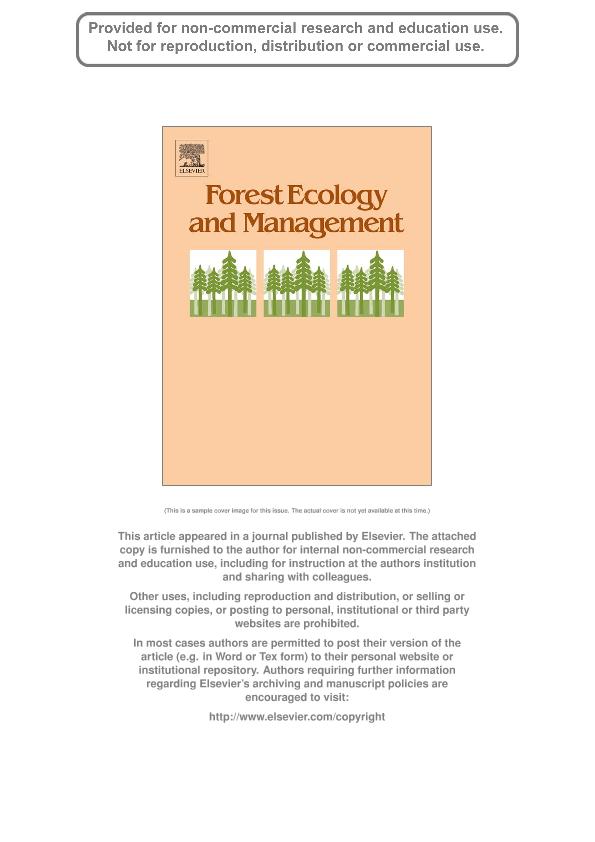Mostrar el registro sencillo del ítem
dc.contributor.author
Svriz, Maya

dc.contributor.author
Damascos, Maria Angélica

dc.contributor.author
Schaumberg, Heike

dc.contributor.author
Hensen, Isabell
dc.date.available
2018-06-26T15:30:26Z
dc.date.issued
2013-02
dc.identifier.citation
Svriz, Maya; Damascos, Maria Angélica; Schaumberg, Heike; Hensen, Isabell; The exotic shrub Rosa rubiginosa as a nurse plant. Implications for the restoration of disturbed temperate forests in Patagonia, Argentina; Elsevier Science; Forest Ecology and Management; 289; 2-2013; 234-242
dc.identifier.issn
0378-1127
dc.identifier.uri
http://hdl.handle.net/11336/50068
dc.description.abstract
Facilitation of forest native species under exotic nurse plants may differ between climatic regions and microsites. Recruitment of other exotic species should be taken into account when areas invaded by exotic shrubs are considered for forest restoration. Natural regeneration of native and exotic species and survival of planted native saplings under the deciduous exotic Rosa rubiginosa (shrub microsite = SM) and in open microsites (OM) were studied in preexisting shrublands of mesic and wet regions in North Patagonia. Light levels, soil chemical composition and seasonal variation of soil moisture were analyzed in SM and OM and the content of N and C was compared between mature and senescent R. rubiginosa leaves. In the SM, native species received less light and soils had higher C:N rate and moisture in spring than in the OM. R. rubiginosa reabsorbs this nutrient before leaves fall. Natural native forest species recruitment occurred only in the SM. In shrublands of the mesic region native species richness and abundance increased under bigger nurse plants. In the wet region, where herbivory was higher, moderate climatic conditions allowed greater species richness and abundance than in the mesic region, independently of the nurse plant volume. The height of the exotic shrub and the protected species showed a positive and negative relationship in the mesic and wet region, respectively. Exotic species grew under 5-15% of the nurse plants (n= 60). Survival of planted saplings, shoot resprouting and herbivore-related mortality were highest in the SM and in wet regions. Sapling mortality due to drying out was highest in the OM of the mesic region. It is possible for forest restoration in areas previously invaded by R. rubiginosa to achieve highly positive results in mesic regions where plants are protected from desiccation. In areas with moderate climatic conditions, facilitation against herbivores has beneficial initial effects, but as the nurse plant competes with taller native individuals, forest restoration would depend on effective control of the nurse plant biomass. In both areas other exotic species would be well represented in the long term. © 2012 Elsevier B.V.
dc.format
application/pdf
dc.language.iso
eng
dc.publisher
Elsevier Science

dc.rights
info:eu-repo/semantics/openAccess
dc.rights.uri
https://creativecommons.org/licenses/by-nc-sa/2.5/ar/
dc.subject
Austrocedrus Chilensis
dc.subject
Exotic Plant
dc.subject
Facilitation
dc.subject
Forest Restoration
dc.subject
Nothofagus Dombeyi
dc.subject.classification
Otras Ciencias Biológicas

dc.subject.classification
Ciencias Biológicas

dc.subject.classification
CIENCIAS NATURALES Y EXACTAS

dc.title
The exotic shrub Rosa rubiginosa as a nurse plant. Implications for the restoration of disturbed temperate forests in Patagonia, Argentina
dc.type
info:eu-repo/semantics/article
dc.type
info:ar-repo/semantics/artículo
dc.type
info:eu-repo/semantics/publishedVersion
dc.date.updated
2018-06-22T15:53:51Z
dc.journal.volume
289
dc.journal.pagination
234-242
dc.journal.pais
Países Bajos

dc.journal.ciudad
Amsterdam
dc.description.fil
Fil: Svriz, Maya. Consejo Nacional de Investigaciones Científicas y Técnicas; Argentina. Universidad Nacional del Comahue. Centro Regional Universitario; Argentina
dc.description.fil
Fil: Damascos, Maria Angélica. Universidad Nacional del Comahue. Centro Regional Universitario; Argentina
dc.description.fil
Fil: Schaumberg, Heike. Martin Luther University; Alemania
dc.description.fil
Fil: Hensen, Isabell. Martin Luther University; Alemania
dc.journal.title
Forest Ecology and Management

dc.relation.alternativeid
info:eu-repo/semantics/altIdentifier/doi/https://dx.doi.org/10.1016/j.foreco.2012.09.037
dc.relation.alternativeid
info:eu-repo/semantics/altIdentifier/url/https://www.sciencedirect.com/science/article/pii/S0378112712005889
Archivos asociados
